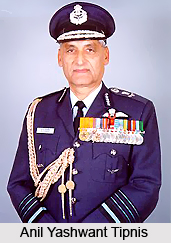 Anil Yashwant Tipnis was born on 15th September 1940. He received his education from Barnes High School at Deolali. In 1956 he joined the National Defense Academy. After that he took flying training from the Air Force Flying College in 1959.He was commissioned into the Indian Air Force as a fighter pilot in 1960. He was awarded the coveted Majumdar Trophy for his outstanding performances in Flying colours training. Initially he was the operational pilot in many fighter Squadrons including MiG-21 Squadron. During the time of 1965 war he was serving with the First Supersonics.
Anil Yashwant Tipnis was born on 15th September 1940. He received his education from Barnes High School at Deolali. In 1956 he joined the National Defense Academy. After that he took flying training from the Air Force Flying College in 1959.He was commissioned into the Indian Air Force as a fighter pilot in 1960. He was awarded the coveted Majumdar Trophy for his outstanding performances in Flying colours training. Initially he was the operational pilot in many fighter Squadrons including MiG-21 Squadron. During the time of 1965 war he was serving with the First Supersonics.
In his graduation as a Pilot Attack Instructor he stood first in the exam and was awarded the Naronha Trophy. After that Anil Yashwant Tipnis sent to Iraq as a Pilot Attack Instructor in 1970.He came back to India and was appointed, as the Commander of No.45 Squadron. He did course from Tactics & Air Combat Development Establishment became the Fighter Combat Leader. He was appointed as the staff of the Combat Development & Training Flight. In 1975 Anil Yashwant Tipnis did course from Defence Services Staff College at Wellington. In 1977 he was given the charge of No.23 Squadron consisting of MiG-21bis aircraft. He was selected for the Indo-Soviet Joint Space mission. Anil Yashwant Tipnis was also appointed as the Chief Instructor (Air) and Battalion Commander of National Defense Academy. In 1983 he was the leader of Mirage Project Team to France. Three years later he returned to India and was appointed to the Mirage 2000 base as the Air Officer Commanding. He was promoted to the rank of Air Commodore and was posted to the Air Force Station Gwalior. In 1989 he did defense studies course from National Defense College, New Delhi and subsequently appointed as the Deputy Personnel Officer at Air HQ in New Delhi.
In 1992 Anil Yashwant Tipnis was promoted to the rank of Air Vice Marshal and was posted as the Assistant Chief of the Air Staff (Inspection) at Air Headquarters and in the next year he was appointed as the Air Officer Commanding in J&K area. Anil Yashwant Tipnis rose to the rank of Air Marshal and commanded the Eastern command. He also served as Senior Air Staff Officer and AOC-in-C of western command. In 1997 he was selected for the rank of Vice Chief of Air Staff. He assumed the charge of Air Chief Marshal as the 18th Chief Staff of Indian Air Force in 1998.
In his long career, Air Chief Marshal Tipnis was awarded the Param Vishisht Seva Medal, Ati Vishisht Seva Medal and Vayu Sena Medal for dedicated service to the nation. Anil Yashwant Tipnis retired from the service on 31 December 2001.




















